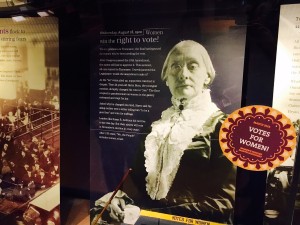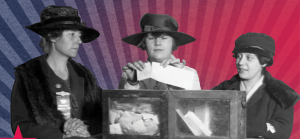Beyond Suffrage and the Right to Vote
 In the month of March, our nation celebrates Women’s History Month and organizations throughout the country bring together lectures, events, and exhibits to honor the achievements of Women from the past. In Philadelphia, there were many different events being held throughout the city to celebrate Women’s History Month. The event I chose to attend was held at the National Constitution Center. I thought it would be interesting to view their advertised exhibit about Women’s roles in the Constitution. I went with pretty high expectations, as I thought a place as well known as the National Constitution Center would have a great Women’s exhibit, but unfortunately, my enthusiasm for this event went from high to low very quickly.
In the month of March, our nation celebrates Women’s History Month and organizations throughout the country bring together lectures, events, and exhibits to honor the achievements of Women from the past. In Philadelphia, there were many different events being held throughout the city to celebrate Women’s History Month. The event I chose to attend was held at the National Constitution Center. I thought it would be interesting to view their advertised exhibit about Women’s roles in the Constitution. I went with pretty high expectations, as I thought a place as well known as the National Constitution Center would have a great Women’s exhibit, but unfortunately, my enthusiasm for this event went from high to low very quickly.
Going into the Constitution Center main exhibit, I expected to see at least a section of the room that was very clearly dedicated to women’s history month, something that would stand out amongst everything else, to celebrate women’s achievements in history. I was disappointed when I found out that this “exhibit”, which was really just a few small pieces of women’s history, were scattered throughout the main exhibit and I really had to search for them. They did not stand out as I had hoped. There were only four aspects of Women’s history that were on display. These included the following: some information about a few women in their virtual touch screen “American National Tree”, a letter by Susan B. Anthony and a few items from the women’s suffrage movement, Sandra Day O’Connor’s Supreme Court robe and an equal rights amendment button from the 1970s. Although I did find these items interesting, I wanted so much more. I understand that the Constitution Center was presenting women’s events that were relevant to the Constitution, but I still expected a more elaborate exhibit at least for this celebratory month.
The Nineteenth Amendment and women’s suffrage were the two most prominent aspects of women’s history that the exhibit focused on, but this focus was very broad and it left out some other very important changes that came along with suffrage and voting. In Reva B. Siegel’s article “She the People: The Nineteenth Amendment, Sex Equality, Federalism, and the Family,” she mentions that the passing of the Nineteenth Amendment not only gained women the right to vote, but that “in the immediate aftermath of ratification, both the Supreme Court and Congress understood the Nineteenth Amendment to redefine citizenship for women in ways that broke with the marital status traditions of the common law” (1018). This right went against everything that a “true woman” should be, and now America’s “new woman”, with her extravagant hats and comfortable pants, was able to participate in the voting process, one of the most important parts of American society, without the need of man. These are among many of the very important changes that women went through in the process of gaining the right to vote, and sadly, they are not really mentioned in the exhibit.
The Constitution Center offers other Women’s History Month events, including a lecture and an interactive show that have gotten great reviews and I am sure they are wonderful, but I chose to go to the general exhibit and to do the “Women’s History Self-Guided Tour” because I wanted to see how or if they changed the main exhibit to integrate some kind of special tribute to women’s history. What I found did not feel special, and I walked away from this experience thinking about how much women’s history is really available to the public. The information that is available to the general public about the history of women is so selective and I feel that if I hadn’t learned so much about women’s history in college, I would never have the knowledge that I do now, without having to do my own research. The most pleasing aspect of my trip was the area of the gift shop that had an entire revolving rack of children’s books dedicated to women, which I found very amusing and totally unexpected due to the limited amount of information on women in the exhibit. There were several coloring books dedicated to famous American women and the first ladies. There was also a paper doll book called “Fashions of the First Ladies Paper Dolls”. These coloring books are just about the only kind of women’s souvenir you could buy, besides a few Betsy Ross items and although they were coloring books which were very clearly made for little girls, they made me feel a little bit more hopeful, and a little bit jealous that I never had one growing up.
Works Cited
Siegel, Reva B. “She the People: The Nineteenth Amendment, Sex Equality, Federalism, and the Family”. Harvard Law Review 115.4 (2002): 947–1046. JSTOR. Web.

